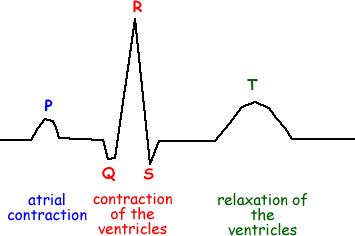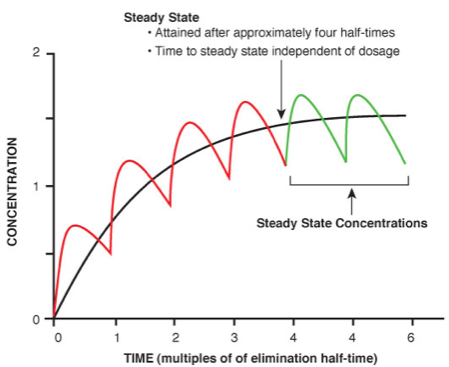Cardiac Glycosides have two prominent effects:
Increased Contractility of the Heart
The longer calcium stays in a cell, the harder and longer the contraction will be. Cardiac glycosides decrease the hearts ability to pump calcium out of the cardiac cell so we get increased contractility of the heart. This is known as an increased inotropic effect. This leads to an increase in cardiac output (greater contractility and duration) in a failing heart.
Decreased AV Node Conduction
The AV node is the gate. When you decrease AV node conduction, the gate stays closed longer and the amount of electrical activity going from the atrium to the ventricle decreases. This is known as a decreased chronotropic effect. This helps prevent atrial fibrillation from becoming ventricular fibrillation.
Therapeutic Monitoring
- The lower end dose works on increasing contractility.
- The higher end dose works on decreasing AV node conduction.
- But the therapeutic index is very narrow so we don’t have a lot of play with this.
We must hold the dose if the apical pulse is <60: Nurses must always monitor the apical pulse of a patient before administering a cardiac glycoside. If it’s below 60, you must not give the medication. You must call the physician because the patient may be toxic.
Why is the pulse rate so important with cardiac glycosides?
 Quick reminder of P, QRS, T.
Quick reminder of P, QRS, T.
- P = atrial contraction
- QRS = for the most part, ventricles are contracting
- T = repolarization
Since cardiac glycosides work on the AV node, as the dose increases the gate closes longer and longer.
In 1st Degree AV block, the EKG would have a long PR interval because the conduction decreased through the AV node. This means we’d have less QRS beats. This gives us a warning that if the apical pulse is less than 60, then we could be in 1st degree AV block. If you don’t heed that warning, without getting into 2nd degree block, we could throw them into 3rd degree AV block. In 3rd degree AV block, nothing is getting through that AV node. This is when the automaticity of the heart takes over which looks like pre-fibrillation.
Serum drug levels: We monitor the serum drug levels because of the narrow therapeutic index. When you get lab results back, most medication blood levels come back as micrograms per deciliter (mcg/dL). Cardiac glycosides come back in nanograms per deciliter (10^-9).
Serum calcium: In phase 2 of the action potential, calcium is slowly entering the cell and this is when we have contraction. Too much calcium, hypercalcemia, will make the contraction too hard.
Serum potassium: In phase 3 of the action potential, potassium exits the cell and we have repolarization, If a person doesn’t have enough potassium, they can’t recover. So even if a person is therapeutic with the serum drug level, but hypokalemic, it’s a big deal. Why would they be hypokalemic? Maybe because they are on a diuretic.
EKG: We also monitor the EKG for reasons stated above.
Pharmacokinetics of Cardiac Glycosides
Steady-state: If we give a person a drug orally, it goes through the intestinal tract, blood levels kick in, and when the kidneys kick in, we start eliminating the drug. We need to know the half-life of a drug because that’s what the dose is based on. Before the drug blood level drops too much due to the half-life, we give another dose. The average blood level will increase every time we redose. After the 5th half-life, we reach steady-state and this is the range we want to stay in permanently.
Digoxin, the most common glycoside, has a half-life of 24 hours for those with normal kidney functions. It will take 5 days to reach a steady state concentration if we give them digoxin. In an emergency, this is unacceptable, so the other option we have is to give a loading dose.
Loading Dose: A loading dose is typically given by IV instead of orally. So we give a dose that hopefully gets them up to the steady state faster. We calculate the dose based on their body weight, fat, etc but if we are wrong with that calculation, they could be toxic. So we give them half the loading dose, then 6 hours later we give a quarter of the loading dose and then 6 hours later we give another loading dose. So in 12 hours we can get the person to the steady state.
What if we fuck up with the Digoxin? Digibind, the antidote to Digoxin, binds up excess digoxin and eliminates it.
Importance of Bioavailability of Digoxin
You don’t have to memorize the numbers, but understand the concept.
- Intravenous = 100%
- Intramuscular = 80%
- Tablet = 70%
Sometimes you’ll see an order such:
Digoxin 0.25mg p.o. daily. If unable to swallow, give dose IVP.
What’s wrong with this order? We’re dealing with a drug with a very narrow therapeutic index and if we do it through IV push, they’re going to get 100% of the drug instead of 70%. The physician has not specified the IV dosage! It would need to be reduced by at least 30%.
Toxicities
- A-V Block (1st degree = delayed PR interval, 3rd degree = nothing getting through the AV node)
- Sinus bradycardia (apical pulse <60)
- Arrhythmias
- Yellow-green halo vision is a classical symptom patients may see around lights. This is a warning sign.
- CNS: Headaches, etc
Toxicity Therapy
- Discontinue Cardiac Glycoside and talk to the doctor.
- Digoxin immune fab (Digibind)
- Correct hypokalemia: Administer potassium intravenously (not IV push but diluted in a bag)
Therapeutic Uses
We utilize cardiac glycosides such as digoxin during congestive heart failure and adjunct therapy for atrial fibrillation.







